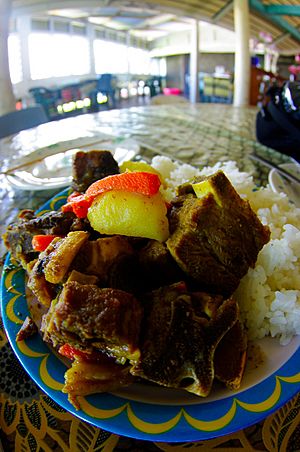Tuvaluan cuisine facts for kids
The cuisine of Tuvalu is the traditional food of a small island nation in the Pacific Ocean. It mainly uses local ingredients like coconuts and different kinds of fish found in the ocean and the calm waters of the lagoons. A very important plant for food is called Pulaka, also known as swamp taro. It gives people lots of energy. Nowadays, rice is also a big part of the diet.
Coconuts are used in many ways. People drink coconut water, use coconut milk, and eat the coconut flesh to make dishes taste good. Many desserts on the islands are made with coconut and coconut milk instead of milk from animals.
Traditional Foods of Tuvalu
The main traditional foods in Tuvalu are pulaka, which is a plant similar to taro but with bigger leaves and roots. Other important foods include bananas, breadfruit, and coconuts. Tuvaluans also eat lots of seafood, like coconut crab, fish from the lagoon and ocean, and even some seabirds. Pork is also eaten, especially during special parties.
Seafood provides important protein. Bananas and breadfruit are extra crops that add to the diet. Coconuts are used for their juice, to make drinks like toddy (a type of palm wine), and to make dishes taste better. Pork is mostly eaten at fateles, which are big parties with dancing to celebrate special events.
Farmers in Tuvalu focus on growing coconut trees and pulaka. Pulaka is grown in large pits filled with composted soil, which are dug deep enough to reach the water underground. Pulaka is the main source of energy for islanders and is usually eaten with fish.
Since raw pulaka roots can be toxic, they must always be cooked. People usually cook them in an earth oven, which is a pit dug in the ground with hot stones. Many recipes add coconut cream or toddy, or both. On the island of Niutao, a dish called tulolo is made by pouring coconut cream over mashed pulaka. A similar dish on Nukufetau is called tulolo pulaka if it uses halved pulaka roots, and fakapapa if the roots are mashed.
Fekei is another dish made on all the islands. It uses grated pulaka, often done by women using a special limestone tool. The grated pulaka is then wrapped in pulaka leaves and steamed. After steaming, it's mixed with coconut cream.
How Tuvaluan Food Changed Over Time
Because the islands of Tuvalu are far away from other countries, their food traditions haven't been influenced much by their neighbors. However, since Tuvalu was a British colony a long time ago, in the 1800s, some British cooking ideas and meals have mixed with local flavors.
The special pits where pulaka is grown are now at risk because of rising sea levels. This means more saltwater gets into the soil, which can harm the pulaka plants. Besides rising saltwater, people's changing lifestyles and eating habits also threaten pulaka farming. This started during and after World War II, when American soldiers brought in lots of imported foods. Many pulaka pits were no longer cared for.
Imported foods often have a lot of sugar. This has led to more dental problems for people. Tuvaluans also started eating more canned foods supplied by the American forces. Even after the war, this change in diet continued, which had long-term effects on health. People in Tuvalu began eating more canned corned beef, rice, and sugar. They eat these foods even when fresh fish and traditional vegetables are available. This new diet is thought to be causing more cases of diabetes, high blood pressure, and other heart-related diseases among Tuvaluans.
Different Diets Across the Islands
The food people eat varies across Tuvalu's nine islands, but they all rely on seafood, fish, and local plants like taro. Most people live on Funafuti Island. Even though Funafuti is small, the food there often represents the whole country.
In Funafuti, which is the capital, seafood and meat dishes are more common than mashed vegetables or soups. On the outer islands, taro is the main food and is used in many ways. You can find taro leaf and coconut soup, taro leaf au gratin (baked with a topping), taro chips, taro cakes, and palusami. These dishes can also be found in Hawaii.
Palusami, also called samoa, is a dish served with taro or breadfruit. It is made from taro leaves (sometimes replaced with spinach), coconut cream, lime juice, onions, and spices.


